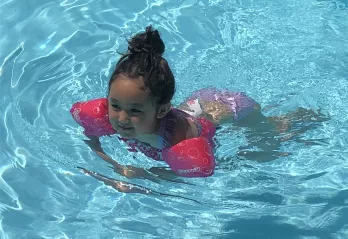Puddle Jumpers - A Love and (Mostly) Hate Relationship

Head to a community pool this summer and you will likely see plenty of kids in colorful vests often refered to as Puddle Jumpers.
In case you do not know, a Puddle Jumper is a combination life jacket, swim aid and swim vest. A child slips his or her arms through the arm floats of the puddle jumper, and then it is buckled behind the back to secure it. Puddle Jumpers are approved by the Coast Guard and are considered a type III personal flotation device (PFD).
Full disclosure, I am a certified swim instructor at the YMCA and a parent –and I have a love, but mostly hate, relationship with Puddle Jumpers.
The Love
I have watched the evolution of the Puddle Jumper from water wings to its current model and will say that it is a massive improvement. Arm floaties or water wings are NOT Coast Guard approved and serve no purpose in keeping your child safe in the water. There is no body or head support with those blow up rings, so don’t waste your money - or risk your child's safety.
Puddle Jumpers are great for a parent’s peace of mind around water. They help support the child’s upper body reducing the risk of drowning. Parents can’t be everywhere at once, so it is helpful to have your child wear a puddle jumper or lifejacket at the pool or beach.
The Hate (or at least a strong dislike!)
If you want your child to learn how to swim, TAKE OFF the Puddle Jumper! (Of course, you should be supervising and within an arm’s reach.)
Children who spend all of their time in the water with the Puddle Jumpers are missing out! They become dependent on the PFD and do not learn basic survival techniques – like floating on their backs. What will they do if they accidentally get knocked into a pool?
I have found that many children who wear Puddle Jumpers forget they have arms - and don't understand the importance of their arms in learning to swim. They have become so accustomed to having their arms float, they neglect using them, even during a swim lesson! Kids who are a little more comfortable in the water will swim with their face in and kick beautifully – but their arms will be dangling at their sides. Kids learning to tread water, are suddenly stunned that they have to kick a little harder to keep their head above water, and ‘wait, what are we supposed to do with our arms?’ they ask.
The Compromise
This is not intended to parent shame – Puddle Jumpers serve a purpose, and are a great tool for when you need a little extra security, like when you have multiple kids under your care at the pool or keep getting phone calls from work. Accidental drowning is the leading cause of death in children one to four years old, and the second leading cause of death in children five to 14 years old, so non-swimmers should always wear a PFD when not in direct contact with a responsible person.
But don’t forget to let your child feel what it is like to be in the water without being dependent on a PFD (with you nearby!). And, of course, swim lessons are a great idea to help teach kids the importance of their arms in swimming.
Article by Leah Tobin, a swimming lesson instructor at the West Chester Area YMCA